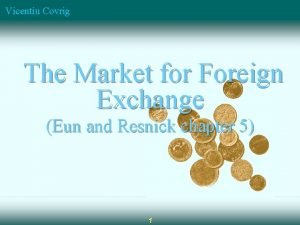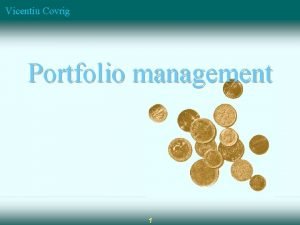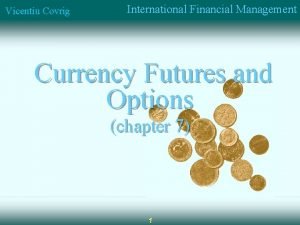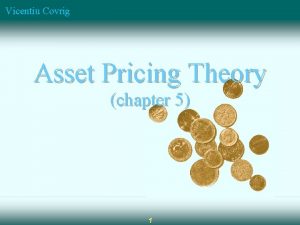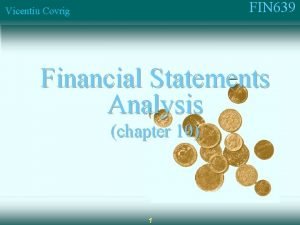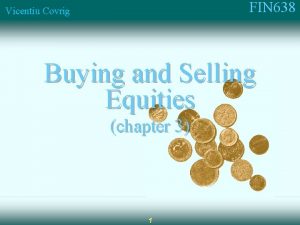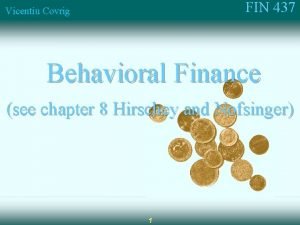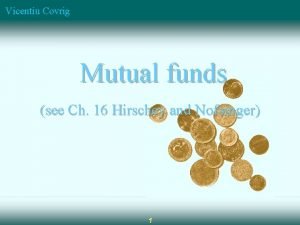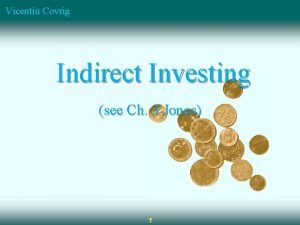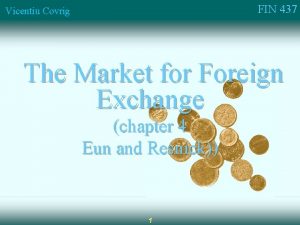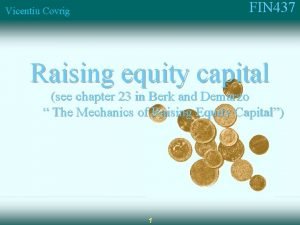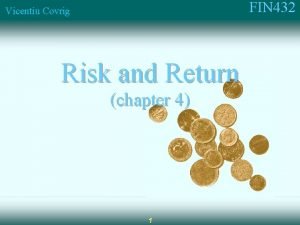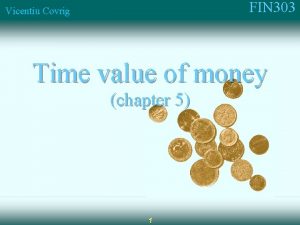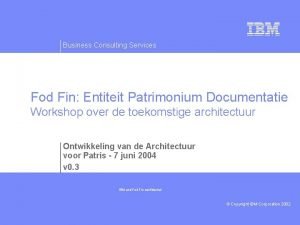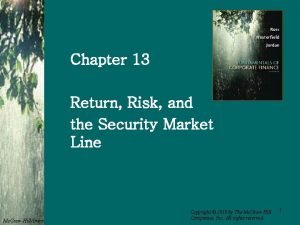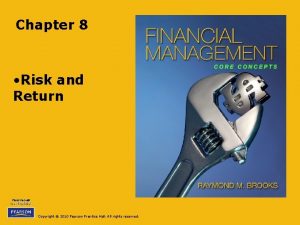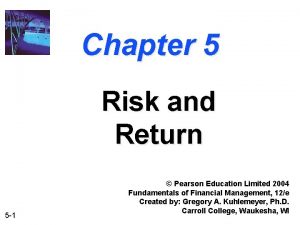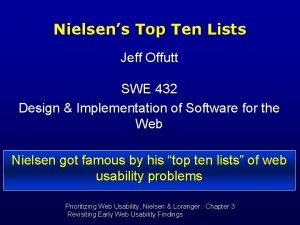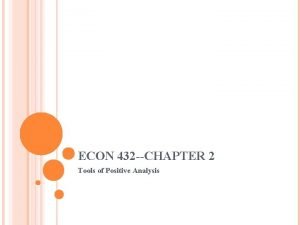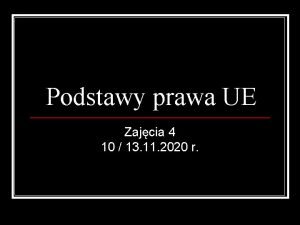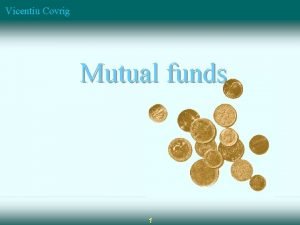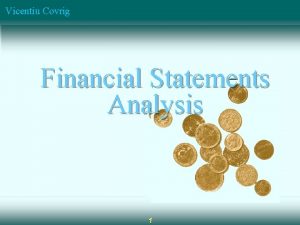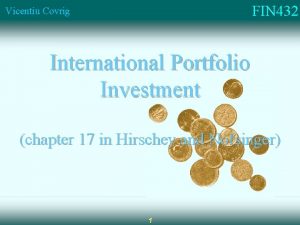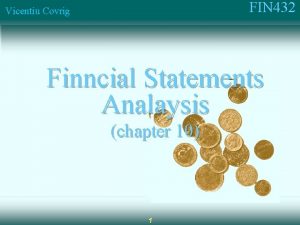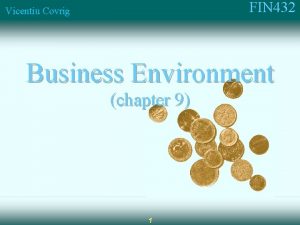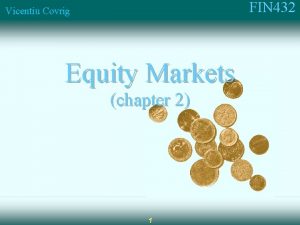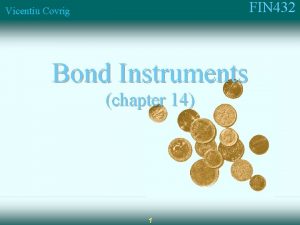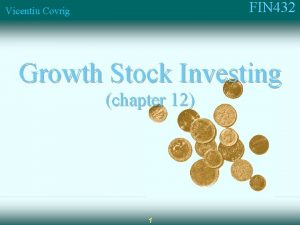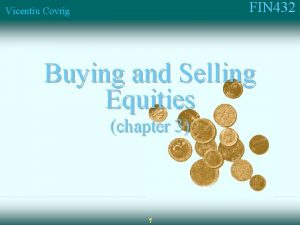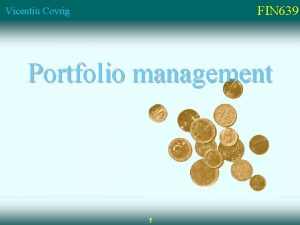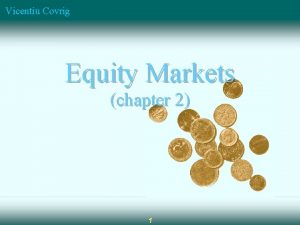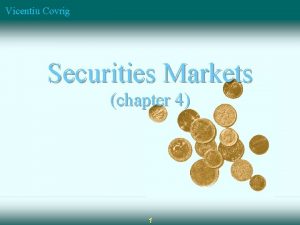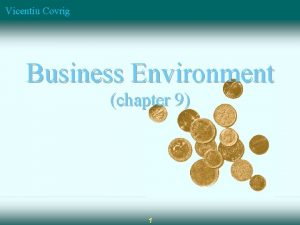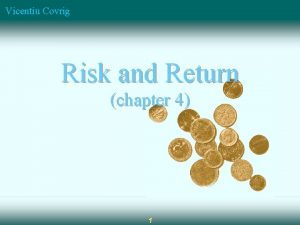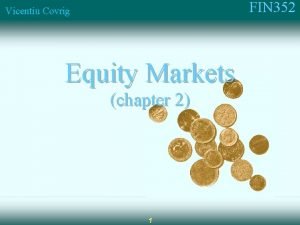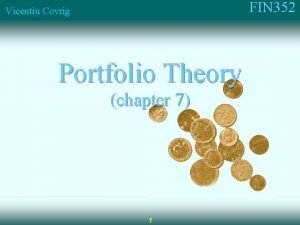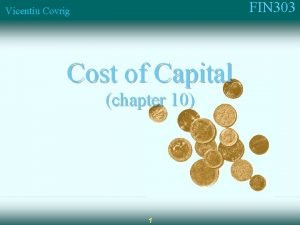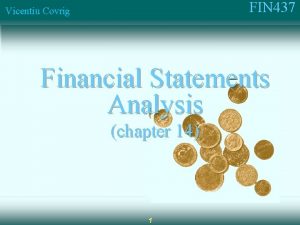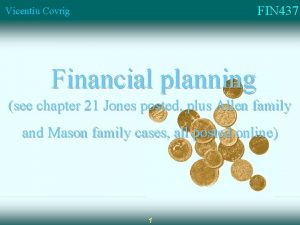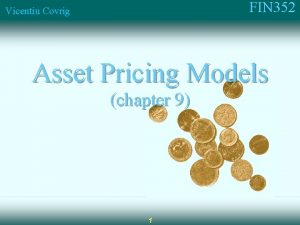FIN 432 Vicentiu Covrig Risk and Return chapter


























- Slides: 26

FIN 432 Vicentiu Covrig Risk and Return (chapter 4) 1

FIN 432 Vicentiu Covrig Risk and Return The investment process consists of two broad tasks: • security and market analysis • portfolio management 2

FIN 432 Vicentiu Covrig Risk and Return Investors are concerned with both § expected return § risk As an investor you want to maximize the returns for a given level of risk. The relationship between the returns for assets in the portfolio is important. 3

FIN 432 Vicentiu Covrig Risk Aversion Portfolio theory assumes that investors are averse to risk n Given a choice between two assets with equal expected rates of return, risk averse investors will select the asset with the lower level of risk n It also means that a riskier investment has to offer a higher expected return or else nobody will buy it 4

FIN 432 Vicentiu Covrig Top Down Asset Allocation 1. Capital Allocation decision: the choice of the proportion of the overall portfolio to place in risk-free assets versus risky assets. 2. Asset Allocation decision: the distribution of risky investments across broad asset classes such as bonds, small stocks, large stocks, real estate etc. 3. Security Selection decision: the choice of which particular securities to hold within each asset class. 5

FIN 432 Vicentiu Covrig Components of Return n Required Return - The return required to compensate for the amount of risk expected. n n Nominal risk-free rate - Risk-free rate - Inflation Required risk premium - Return that varies with the risk entailed 6

FIN 432 Vicentiu Covrig Computing Returns n Arithmetic average return n - Example 1: (0. 10+0. 08 -0. 04)/3 = 0. 0467 or 4. 67% - Example 2: (0. 50 -0. 50)/2 = 0 or 0% Geometric mean return - Example 1: (1. 1× 1. 08× 0. 96)1/3 – 1 = 0. 0448 or 4. 48% - Example 2: (1. 5× 0. 5)1/2 – 1 = -0. 134 or -13. 4% 7

FIN 432 Vicentiu Covrig 8

FIN 432 Vicentiu Covrig Risk n Variation, or volatility of return - Most investors probably are more interested the - chance of losing money Standard deviation - Example 1: {[(0. 10 -0. 0467)2 + (0. 08 -0. 0467)2 + (-0. 0467)2] / (3 -1) }1/2 = 0. 0757 or 7. 57% 9

FIN 432 Vicentiu Covrig Risk and Return n Risk/Return relationship - The greater the risk, the more return should be demanded. - Coefficient of Variation Co. V = 7. 57% / 4. 67% = 1. 62 10

FIN 432 Vicentiu Covrig Annual data, 1950 to 2007 Long-Term Short-term Common Treasury Inflation Stocks Bonds Bills Rate Arithmetic average 13. 15% 6. 37% 4. 89% 3. 87% Median 15. 40% 3. 65% 4. 85% 3. 19% Geometric mean 11. 84% 5. 92% 4. 89% 3. 83% Standard deviation 17. 24% 10. 51% 2. 71% 2. 99% 1. 30 1. 64 0. 55 0. 77 Coefficent of variation 11

FIN 432 Vicentiu Covrig More Returns n Total Return - Includes dividends, interest, income, and capital gains (losses) n Inflation - Reduces future buying power - Nominal return u. Return with inflation included - Real return u. Return with inflation removed u. Return as a buying power measurement 12

FIN 432 Vicentiu Covrig Impact of Taxes n Capital Gains - Only realized gains are taxed - Short-term (less than one year) utaxed at marginal income tax rate - Long-term (over one year) u. Taxed at 20% n n Dividends - Taxed at 15% Interest Income - Taxed at marginal income tax rate 13

FIN 432 Vicentiu Covrig Forming a Portfolio n Don’t put all your eggs in one basket! n The purpose of owning different types of stocks and different asset classes is diversify. n The main goal of diversification is to reduce overall investment risk. 14

Vicentiu Covrig n n n Statistical Measures FIN 432 The risk of a portfolio is determined by how the individual securities co-move over time. Covariance is a measure of that co-movement: However, the standardized measure of correlation is more popular: - Between -1 and 1 15

FIN 432 Vicentiu Covrig The benefits of diversification n Come from the correlation between asset returns n The smaller the correlation, the greater the risk reduction potential greater the benefit of diversification n If r = +1. 0, no risk reduction is possible § Adding extra securities with lower corr/cov with the existing ones decreases the total risk of the portfolio 16

FIN 432 Vicentiu Covrig Portfolio Risk and Return n Expected Portfolio Return n Standard Deviation of Portfolio Returns 17

FIN 432 Vicentiu Covrig 18

FIN 432 Vicentiu Covrig Combining these investments allows for the possibility of risk reduction n n The goal of the investor is to form a portfolio the moves to the upper-left corner of the risk/return graph. The very highest level of return for each level of risk desired is the efficient portfolio. All the efficient portfolios make up the efficient frontier. The optimal portfolio for you is the one that maximizes your utility (given your risk aversion) 19

FIN 432 Vicentiu Covrig 20

FIN 432 Vicentiu Covrig 21

FIN 432 Vicentiu Covrig 100% stocks 100% bonds Note that some portfolios are “better” than others. They have higher returns for the same level of risk or less. We call this portfolios EFFICIENT. 22

FIN 432 Vicentiu Covrig E(r) The Minimum-Variance Frontier of Risky Assets Efficient frontier Individual assets Global minimum variance portfolio Minimum variance frontier St. Dev. 23

FIN 432 Vicentiu Covrig Investor Perceptions of Risk n n Portfolio theory is based on the statistics of how investment returns co-move over time. Do people really view risk from this statistical perspective? - No, people tend to see high returns as safe. When the markets - go up, people jump in. Risk is felt after returns turn negative Myopic view (short-term perspective) u After 3 -years of losses, long-term investors become 3 -year investors—they want out! - House Money Effect u After experiencing a gain, or profit, gamblers become willing to take more risk. 24

FIN 432 Vicentiu Covrig Investor Risk Perceptions Make the Use of Portfolio Theory Difficult for Real Investors n People mentally keep track of things in separate mental “file folders, ” called mental accounting. - The profits, losses, return of each investment are n considered separately. This makes thinking in terms of the interaction between investments difficult. The result, is that people frequently fail to diversify. 25

FIN 432 Vicentiu Covrig Learning objectives Know the concepts of risk and return. Know the components of return. Know how to calculate average and geometric mean Know how to calculate standard deviation and the coefficient of variation Firm and market specific risks Know the concepts of correlation and diversification Discuss the efficient frontier and portfolio; optimum portfolio Discuss the investors perception of risk: myopic, house money effect and mental accounting End of chapter ST 4. 1; questions 4. 1 to 4. 6; CFA problems 4. 1 to 4. 5 26
 Vicentiu covrig
Vicentiu covrig Vicentiu covrig
Vicentiu covrig Vicentiu covrig
Vicentiu covrig Covrig,vicentiu m
Covrig,vicentiu m Vicentiu covrig
Vicentiu covrig Vicentiu covrig
Vicentiu covrig Vicentiu covrig
Vicentiu covrig Vicentiu covrig
Vicentiu covrig Vicentiu covrig
Vicentiu covrig Vicentiu covrig
Vicentiu covrig Vicentiu covrig
Vicentiu covrig Vicentiu covrig
Vicentiu covrig Vicentiu covrig
Vicentiu covrig Vicentiu covrig
Vicentiu covrig Spf fin fod fin
Spf fin fod fin Prisme à base trapézoidale
Prisme à base trapézoidale Financial management chapter 8 risk and return
Financial management chapter 8 risk and return Chapter 13 return risk and the security market line
Chapter 13 return risk and the security market line Chapter 8 risk and rates of return problem solutions
Chapter 8 risk and rates of return problem solutions Chapter 5 risk and return
Chapter 5 risk and return Market risk credit risk operational risk
Market risk credit risk operational risk Sda hymn 432
Sda hymn 432 Swe 432
Swe 432 Swe 432
Swe 432 Eisa 432
Eisa 432 Define positive analysis
Define positive analysis C-432/04
C-432/04
